Destination: Gobbler!
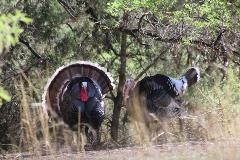 The wild turkey is a native North American bird, probably initially domesticated by early natives in Mexico and definitely first brought to Europe by Spanish explorers in the Eighteenth Century. Today roast turkey is widely appreciated and wild or feral populations are hunted in numerous parts of the world, including Europe and several far-flung islands in the Pacific. The real cult and culture of hunting the wild turkey, however, is a uniquely North American phenomenon. It’s also a relatively new thing. Within living memory—by the 1930s—the native wild turkey population may have been as low as 30,000 — clearly in trouble and extirpated from vast areas.
The wild turkey is a native North American bird, probably initially domesticated by early natives in Mexico and definitely first brought to Europe by Spanish explorers in the Eighteenth Century. Today roast turkey is widely appreciated and wild or feral populations are hunted in numerous parts of the world, including Europe and several far-flung islands in the Pacific. The real cult and culture of hunting the wild turkey, however, is a uniquely North American phenomenon. It’s also a relatively new thing. Within living memory—by the 1930s—the native wild turkey population may have been as low as 30,000 — clearly in trouble and extirpated from vast areas.
Wildlife managers learned effective live-trapping and reintroduction techniques and the recovery of the wild turkey is one many of North America’s greatest conservation success stories. Today, America’s wild population is rapidly headed toward ten million, with turkey hunting now conducted in all U.S. states (except Alaska); across southern Canada; and in northern Mexico and the Yucatan. As amazing as the recovery, is the impact the wild turkey has on American hunting. Fall seasons, though far from universal, are common, but turkey hunting is primarily a springtime pursuit. When the mating season is on, the toms are strutting and gobbling and are most susceptible to calling. Millions of American hunters participate, and an entire industry has developed — calls, camouflage, decoys, specialized guns and loads and much more. After the whitetail deer, America’s spring turkey season is now the most economically important hunt in North America…and thus in the world.
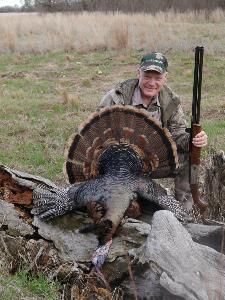 Our turkeys are ground-nesting birds of the Meleagris genus, and we generally consider four varieties across the U.S. (and southern Canada), plus two more or less confined to Mexico. Our SCI records-keeping system now includes wild turkeys, which I consider appropriate not only because of the importance and popularity of turkey hunting, but also because the wild turkey is very much a “big game bird,” hunted like big game.
Our turkeys are ground-nesting birds of the Meleagris genus, and we generally consider four varieties across the U.S. (and southern Canada), plus two more or less confined to Mexico. Our SCI records-keeping system now includes wild turkeys, which I consider appropriate not only because of the importance and popularity of turkey hunting, but also because the wild turkey is very much a “big game bird,” hunted like big game.
Primary criteria for “judging” turkeys include length of beard and spurs, but weight is also important, and all vary among the various races. Some of us are casual about our turkey hunting while many others are deadly serious zealots! The National Wild Turkey Federation (NWTF), which deserves much credit for the amazing recovery of the wild turkey, maintains data and, among their honors are listings of the “grand slam” of the four U.S. varieties: Eastern, Merriam’s, Osceola, and Rio Grande. Their “world slam” includes these four, plus the two primarily Mexican varieties, Gould’s and ocellated.
The NWTF’s listing of “world slam” turkey hunters is now edging toward 400. Many of these folks are the zealots, true experts who have multiple slams and quite a few used archery tackle; a very difficult feat! Certainly, I don’t consider myself a skilled turkey caller! However, my turkey hunting experience goes back to the early 1960s, when Dad and I participated in the first modern turkey season in Missouri’s Ozarks.
We had no idea what we were doing, but we dressed in camo and made strange sounds on box calls…and actually saw wild turkeys, though neither of us took gobblers. As a turkey hunter, I’m probably more casual than zealot, but I finished my own world slam with a Gould’s turkey last spring, nearly 50 years after taking my first turkey! Even though I am no expert, I have to agree that a close encounter with a strutting gobbler, tail feathers fanned out, head fire-engine red, is one of the most exciting events in the hunting world! Although it certainly needn’t take a half-century, eventually hunting all six of our American turkeys is a most worthwhile hunting goal…and it will take you to some interesting corners of the continent.
 Among turkey hunters, there is much debate as to which of the six is the most difficult. As they say, what you see depends on where you sit. This is extremely true of turkey hunting! For most of us, turkey hunting is a backyard enterprise. As most deer hunters hunt their local deer, most turkey hunters hunt their local turkeys, at least first. And since the wild turkey is now almost continent-wide, most American hunters have one or another breed of turkey close to home. Only Alaskans and northern Canadians must consider any turkey hunting a long-range enterprise.
Among turkey hunters, there is much debate as to which of the six is the most difficult. As they say, what you see depends on where you sit. This is extremely true of turkey hunting! For most of us, turkey hunting is a backyard enterprise. As most deer hunters hunt their local deer, most turkey hunters hunt their local turkeys, at least first. And since the wild turkey is now almost continent-wide, most American hunters have one or another breed of turkey close to home. Only Alaskans and northern Canadians must consider any turkey hunting a long-range enterprise.
Here in Kansas, we had exactly zero turkeys when I was a kid. Introductions and reintroductions weren’t always perfect and, given the chance, the various races readily mix. Sometime in the next couple of days I’ll probably see a gobbler strutting up the driveway 40 yards from my desk. Right here it would technically be a hybrid between Eastern and Rio Grande, but ten minutes to the east, I’d be in Eastern gobbler country while less than an hour to the west, I’d be solidly in Rio Grande turkey country. My neighbors to the north in Nebraska and the Dakotas have much the same situation…except they also have Merriam’s turkeys on the western edges.
Most of us, however, have just one turkey close to home, and most turkey hunters learn their skills from their own backyard birds. As with all other forms of hunting, for many that’s enough; not everybody gets bitten by the desire to hunt unfamiliar game over the far horizon. With the wild turkey it can be just as addictive as pursing far-flung varieties of antlered or horned game…and if you’re a turkey hunter, just as interesting. Now that, finally, I’ve hunted them all, here are my thoughts on hunting our six wild turkeys — not as an insider who knows his or her local birds, but as an outsider who must now venture into new country.
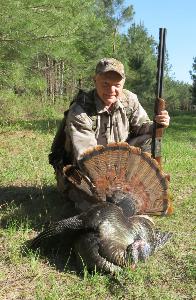 Eastern wild turkey: The Eastern wild turkey occupies the largest range, essentially from the Eastern seaboard to the Great Plains and throughout the Deep South. In farm country, the Eastern gobbler is probably the largest turkey in terms of weight; the heaviest I’ve heard of was a whopping 37 pounds. Amazing!
Eastern wild turkey: The Eastern wild turkey occupies the largest range, essentially from the Eastern seaboard to the Great Plains and throughout the Deep South. In farm country, the Eastern gobbler is probably the largest turkey in terms of weight; the heaviest I’ve heard of was a whopping 37 pounds. Amazing!
The Eastern gobbler has the reputation for being the most difficult turkey to hunt, but to some extent this is because much of its range has a dense human population, and thus more hunting pressure. The Eastern gobbler is a vocal bird; his tribe teaches millions of hunters how to hunt turkeys, and millions of them are better turkey hunters than I will ever be! But it depends on where you sit. For sure the Eastern turkeys off to my right in eastern Kansas are probably a bit more gullible than their cousins in harder-hunted New York or Pennsylvania!
I’ve hunted them here in Kansas and neighboring Missouri, but if I didn’t have Eastern gobblers close to home and needed to find a place to hunt them, I’d consider the Deep South. I’ve had wonderful Eastern gobbler hunts in Alabama, Georgia and Mississippi. Populations are high, and while the “right time” always varies by a couple of weeks, hunting pressure is moderate and the birds tend to be active and vocal (when the time is right). There are lodges and outfitters scattered through the region, but there’s also adequate public land and timber land, and it’s pretty hard to beat good old Southern hospitality.
Rio Grande: The Rio Grande turkey has a large range from Texas up through the Central Great Plains with generally high populations often forming into large droves. A big, heavy bird, it has more buff in the tail fan than the Eastern bird and is generally considered the most trusting and easiest to hunt of our wild turkeys. Certainly, this has been my experience; I’ve hunted them in Texas, Oklahoma, Kansas and Nebraska. The Rio Grande turkey is the only one that I’ve successfully hunted multiple times by spot-and-stalk tactics, but calling is always more reliable and a whole lot more exciting (when it works!).
From an outsider’s viewpoint Texas probably has the most opportunity with the highest density of outfitters, but Texas is very much a private land state, so for do-it-yourself hunters, Oklahoma, Kansas and Nebraska offer much more public land opportunities.
Both fall and spring seasons are common in Rio Grande turkey country, but in the spring, Rio Grande turkeys are extremely vocal (in part because they are often plentiful). Admittedly neophyte caller that I am, I’ve had the most success calling Rio Grande turkeys.
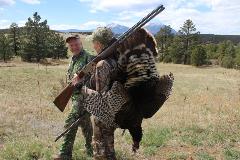 Merriam’s: The Merriam’s turkey is the bird of the Rocky Mountains, found from the western Great Plains westward. It is the most distinct and to my thinking the most beautiful, with lots of buff in the fan and white feathering on the back ahead of the base of the tail. Merriam’s birds are generally a bit smaller; beards and spurs tend to be shorter than the other races. However, in part perhaps because of generally low hunting pressure, Merriam’s turkeys are extremely vocal.
Merriam’s: The Merriam’s turkey is the bird of the Rocky Mountains, found from the western Great Plains westward. It is the most distinct and to my thinking the most beautiful, with lots of buff in the fan and white feathering on the back ahead of the base of the tail. Merriam’s birds are generally a bit smaller; beards and spurs tend to be shorter than the other races. However, in part perhaps because of generally low hunting pressure, Merriam’s turkeys are extremely vocal.
Many expert turkey hunters (which I am not!) consider them the most susceptible to calling. There is great Merriam’s turkey hunting in Colorado, eastern Wyoming and eastern Montana where many big-game outfitters also offer turkey hunting. Public land opportunities are plentiful; western Nebraska is often cited as a prime hotspot for Merriam’s turkey. Honestly, this is the turkey I have the least experience with! Just last week Donna and I had a wonderful Merriam’s turkey hunt with Fred Eichler’s FullDraw outfit in southeastern Colorado at about 7,000 feet with the Spanish Peaks looming in the background…and there were lots of birds!
Osceola: Now we’re getting into turkeys with restricted ranges. If you live in Osceola turkey country, then they’re your birds and you know them…but this is the turkey that gave me the most trouble. Over several trips, I put in a full month of hard hunting before I took my first Osceola gobbler, but maybe it would have happened sooner if I were a better turkey hunter!
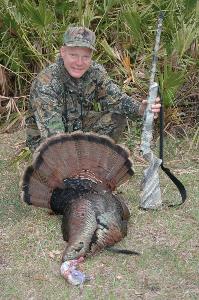 Florida has Eastern birds in the north and panhandle, with Osceola turkeys from about Orlando southward. They are a smaller bird, dark with amazing iridescence in their body feathering with dark wings and bronze tail fain. Living in semi-tropical country, I have found them the least vocal and by far the hardest to call of any of the turkeys, but part of this is the thick, swampy country common in their region.
Florida has Eastern birds in the north and panhandle, with Osceola turkeys from about Orlando southward. They are a smaller bird, dark with amazing iridescence in their body feathering with dark wings and bronze tail fain. Living in semi-tropical country, I have found them the least vocal and by far the hardest to call of any of the turkeys, but part of this is the thick, swampy country common in their region.
Turkeys don’t like water, and often responding birds are blocked by water barriers. I’ve also seen them come right in, so it depends somewhat on luck (like all hunting!). There are a handful of good outfitters offering exceptional success, but Florida also has 5.5 million acres of public land, so the opportunity is there!
Gould’s: Although their range and numbers are very limited in southwestern New Mexico and southeastern Arizona, the Gould’s turkey is found in eight states in northern Mexico, so is probably more widespread than the Osceola turkey.
Although not as heavy, probably because of its arid habitat, it is the tallest and largest-framed of our wild turkeys with the longest legs, largest feet, biggest head, and largest tail fan, an imposing bird! Coloration is similar to the Merriam’s with white on the lower back and very pale fan tips. Beards and spurs tend to be shorter, almost certainly because of their rough, rocky country. They are increasing on the U.S. side with more permits every year, but for most of us, Gould’s turkey requires an outfitted hunt into the mountains of northern Mexico.
As I said, this was my last of the six, in 2017, with Ted Jaycox’s Tall Tine Outfitters in northeastern Sonora. The hunt was wonderful, hunting turkeys in desert mountains shared with Coues whitetails. Only rarely, including on good Texas ranches with oceans of Rio Grande birds, have I seen so many turkeys and so many mature gobblers. Turkey hunting is always a matter of timing, but we hit it right; the gobblers were surprisingly vocal, and both aggressive and responsive to calling.
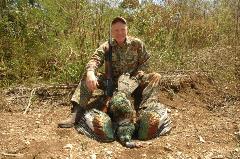 Ocellated: Our other turkeys are subspecies of Meleagros gallopavo, with five subspecies extant. The ocellated turkey of the Yucatan Peninsula was once considered a separate and less-related genus, but is now considered a unique species, Meleagros ocellate, and it is very different from our other birds. It is much smaller; big males run about a dozen pounds and, while they have long, sharp, slender spurs, they do not have the characteristic beards of other turkeys.
Ocellated: Our other turkeys are subspecies of Meleagros gallopavo, with five subspecies extant. The ocellated turkey of the Yucatan Peninsula was once considered a separate and less-related genus, but is now considered a unique species, Meleagros ocellate, and it is very different from our other birds. It is much smaller; big males run about a dozen pounds and, while they have long, sharp, slender spurs, they do not have the characteristic beards of other turkeys.
Feathering is dramatically different; blue-green and almost peacock-like. During the spring mating season, the males do not gobble. The locals call their sound “singing,” and the sound is a series of drum-like thumps. Similar to northern turkeys, the sound is most often heard as they roost at dusk and before flying down at dawn.
Ocellated turkeys can be called in, but it’s unusual. More commonly a singing bird is “stalked,” just like the capercaillie is hunted in Europe, or they are ambushed at watering points and feeding areas. Most hunting opportunities are in southernmost Mexico, but they are also found in Guatemala and Belize.
Taking an ocellated turkey is almost exclusively an outfitted hunt. Hunting them in the Yucatan jungle is a fantastic experience, and they share their unique habitat with some of North America’s least-known animals: Brocket deer, white-lipped peccaries, tropical whitetails, jaguars and ocelots — even tapirs.
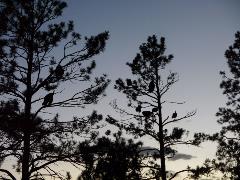 Honestly, on my several trips down there I’ve been more interested in the other jungle species but, although difficult, I’ve found ocellated turkeys plentiful and the hunting highly successful. Whichever your local turkey happens to be, enjoy it and learn from it, but recognize that a whole continent of great turkey hunting lies beyond your horizon!–Craig Boddington
Honestly, on my several trips down there I’ve been more interested in the other jungle species but, although difficult, I’ve found ocellated turkeys plentiful and the hunting highly successful. Whichever your local turkey happens to be, enjoy it and learn from it, but recognize that a whole continent of great turkey hunting lies beyond your horizon!–Craig Boddington

